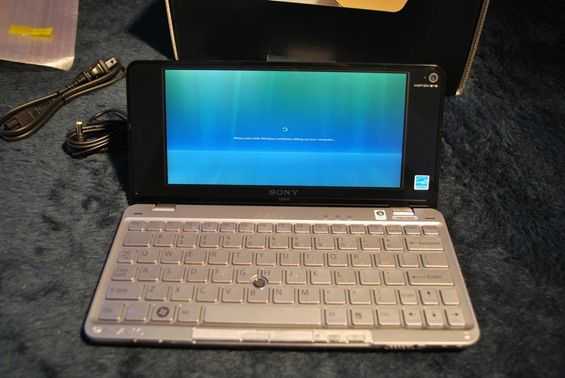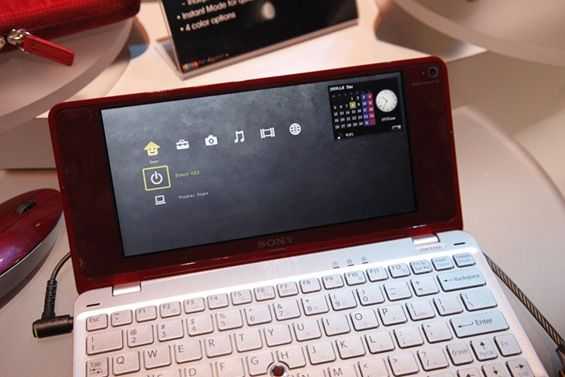
Even though in my experience, Windows XP always runs better than Vista on these type of mobile computers, the VAIO P handles Vista pretty well. The unit comes pre-installed with Windows Home Premium. I opened my unit to a nice clean slate, a perfect Vista install with no bloatware. I’m going to chalk that up to our pals at Dynamism, as Sony is notorious for sending out computers that need to be cleared of bloatware right out of the box (as happened with Jenn’s VAIO P).
Vista took several minutes to set it self up, as usual, as I powered on the VAIO P for the first time. After a fairly lengthy update session thanks to Microsoft, the VAIO P was ready to go. The first thing I generally do with a mobile unit, is go through the different settings and get everything set up so it feels right. I was excited when I found a program provided by Sony called the VAIO Control Center. The VCC lets you adjust a lot of system settings from one well organized page. The best part about this is that there is very little software overlap. That is to say that the VCC changes settings at their base level in the system and don’t get get overridden by other setting adjustments. For instance, the speed of the mouse can be adjusted right inside the VCC. Any changes to the mouse speed in the VCC will be reflected in the default Windows configuration. This is nice compared to some other devices that include their own configuration utilities but override system settings and vice-versa.
Another thing I like that relates to non-software overlap is the hardware buttons that control simple functions like volume and screen brightness. You’ll find these functions bound with an Fn modifier to the F-keys. Adjusting volume up or down using these keys changes the system volume in real-time. This helps keep everything simple, instead of having system volume be different than the volume that the hardware buttons control. The display of the changing levels (volume/brightness) is also very reserved. A very simple box pops up in the lower center of the screen and shows you what the current level is, and how you are adjusting it. There is no obnoxious fade in/fade out effect or any information that you don’t need. They are there when you need them, and gone when you don’t.
Vista is quite responsive. I would hope so given that this is the top end model of the VAIO P. Applications launch quickly and windows come up fast as well. Turning on Aero results is a very visible decrease in performance. Windows drag around the screen at a much slower framerate and the whole unit becomes sluggish. Aero off as I mentioned, feels fine. I would imagine that the particular processing that is needed to render Aero, is not the forte of the integrated graphics. Without a dedicated GPU, the CPU ends up doing the graphics work, and with a 1.86GHz clock, it is best to not ask too much of it is it is already powering Vista fairly well.
There are several pieces of software that Sony has provided that I just don’t get. For example, the ‘VAIO Music Box’ application is an extremely simple media player (too simple in my opinion). It can’t even be maximized, and really just sorts your media by the year it was released, album, or artist. The controls are pretty much limited to track forward/back and play/pause. The one interesting thing about the program is that there is a ‘Chorus Playback’ option which claims to playback only the chorus parts of your songs. This requires a separate application, the VAIO Content Analyzer, which analyzes your songs to identify the chorus parts. Luckily Sony thought to have the VAIO Content Analyzer, which would be constantly running your HDD as it scanned content, disable itself while you are on battery power. Thanks for the though Sony, but I really just don’t feel like it is worth it to begin with, so I’ll skip the content analyzer all together and use a more common media player.
Instant Mode

The VAIO P has a pre-OS that Sony refers to as ‘Instant Mode’. Pressing a hardware button on the unit next to the mouse buttons while the device is powered down will launch it into instant mode. We showed you a bit about Instant mode back when the VAIO P was announced at CES 09. The XMB (PSP or PS3 style interface) is still used a the GUI, and you have access to videos, music, images, an instant messenger, VOIP, and a web browser, all from instant mode. Considering Sony isn’t pushing this as a huge deal (at least from what I’ve seen), I’d say this is a decent attempt at an in-house pre-OS. We’ll get you plenty of detailed info on Instant Mode when we delve deeper into specifics in our long term software impressions piece, stay tuned.











Initial Software Impressions — Sony VAIO P http://www.umpcportal.com/?p=6182
what’s the battery life for browsing on instant mode?
Look for that in the upcoming performance section of the review.
what’s the battery life on both instant mode and full mode?
overall is it worth the expensive price tag?
Reading: Initial Software Impressions — Sony VAIO P | UMPCPortal – The Mobile Internet and Computing Reference Site – http://is.gd/mFal